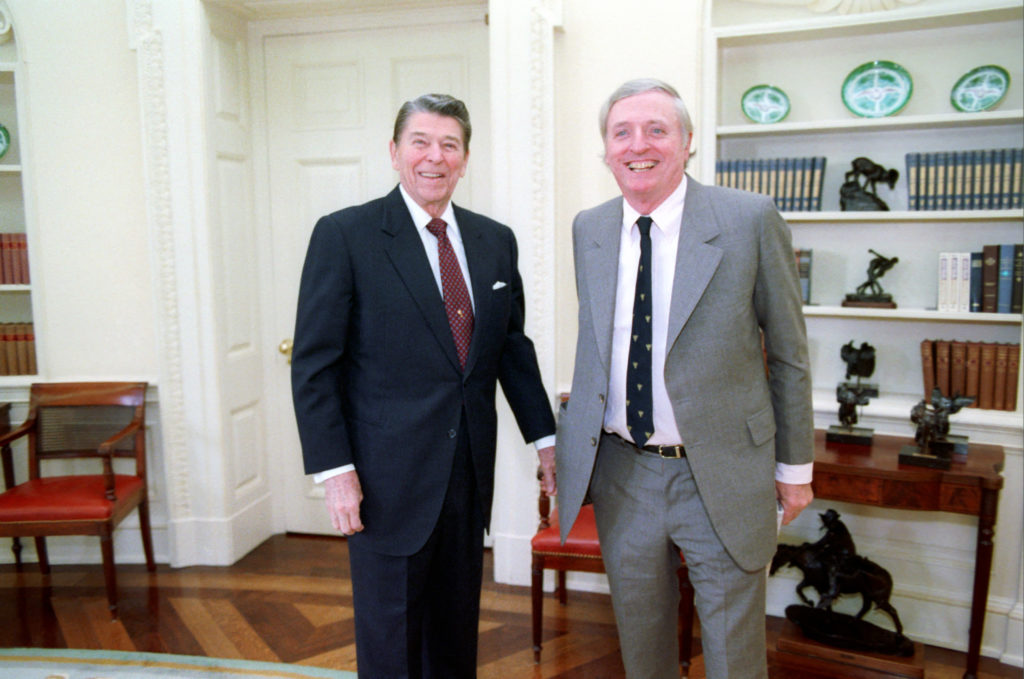Buckley’s America

Everyone wants to put everything wrong with today’s America on Trump and what passes for friends with that guy. Fair enough, but this all has major antecedents. We are living in the America Pat Buchanan envisioned, the America Phyllis Schlafly envisioned, the America Ed Meese envisioned. And the America William F. Buckley envisioned.
In 1955, with the peak of McCarthyism having passed, Buckley assembled an eclectic group of ex-Communists, libertarians, traditionalists, and Catholics to found National Review, a publication for “radical conservatives.” What kind of magazine would it be? And given its indelible association with Buckley, who held a voting majority of stock ownership, what kind of public figure would he become? In its mission statement, Buckley distanced the magazine from the “irresponsible” right, though he declined to name any names. In a letter quoted in John Judis’s 1988 biography of Buckley, he responded to an early complaint that the magazine was too highbrow to be effective by explaining that he wanted to “abjure the popular and cliché-ridden appeal to the ‘grassroots’” and to target “opinion makers.”
But Tanenhaus shows that Buckley and the magazine were also pulled by countervailing impulses. In an early profile of Buckley, the literary gadfly Dwight MacDonald was surprised to hear him defend a crass book by “two peephole Hearst reporters who trafficked in innuendo, smear, and sexual sensationalism” (the book alleged, for instance, that 90 percent of crime in the city of Cleveland was committed by “darkies” and called the University of California, Berkeley “a bed of sexual perversion, left wing teaching and narcotic addiction”). “I don’t like the way the book is written any more than you do,” Buckley admitted. “But it’s on our side.… And anyway you’ve got to write that way to reach a big public.”
For an early issue, the magazine called on McCarthy himself to pan a book by former Secretary of State Dean Acheson, though Bozell actually wrote the review, inserting enough schoolyard invective (“As ‘Brains’ Acheson sees it …”) to impersonate Tailgunner Joe. Tanenhaus notes that National Review’s editors may have striven “for learned hyperliteracy, but as leaders of a nascent movement they were prepared to welcome almost anyone who wanted to join and sought them out, wherever they were to be found—including in groups with names like American Heritage Protective Committee, the American Way, Citizens Grassroots Crusade of South Carolina.”
South Carolina was a state Buckley knew all too well. Some of the most revelatory parts of Tanenhaus’s biography depict the family’s second homestead in Camden, a small city in the middle of the state. At the behest of Buckley’s mother, a “proud daughter of the Confederacy” who never quite felt comfortable in Yankee Connecticut, his father had purchased a sprawling antebellum property that was once owned by the first senator to resign after Lincoln’s 1860 election. There, the family befriended figures like the Dixiecrat Strom Thurmond, who garnered more than 80 percent of the vote in their county in 1948, and the archconservative textile magnate Roger Milliken, later the most munificent National Review donor outside the Buckley family. They employed a staff drawn from the area’s population of Black sharecroppers and domestics, whom they treated relatively well, at least compared to their neighbors. The “family seemed, and in many respects were, models of compassion and fair dealing,” Tanenhaus writes. Yet Buckley’s parents were also the sole financial backers behind a new local newspaper associated with the white supremacist Citizens Councils.
National Review’s shameful defenses of white rule in the South, Tanenhaus shows, drew on Buckley’s own complicated experience of it. On the one hand, he seemed incapable of grasping white supremacy in its vicious totality, given the more genteel and paternalistic form of racism he experienced within his family: “Any suggestion, made to a [white] Southerner, that segregation is in fact a manifestation of ‘race hatred’ elicits from him an expression of sheer wonderment,” he wrote. Yet the magazine also exhibited a “craze” for John C. Calhoun’s defense of states’ rights, and Buckley himself made arguments in public that were “far more incendiary and racist,” according to one historian of the right, than anything said by Robert Welch, the conspiratorial John Birch Society founder whose banishment from the conservative movement Buckley considered a career-defining achievement.
It’s a real wonder that Young Americans for Fascism Freedom still exists today and is all in on Trump.


